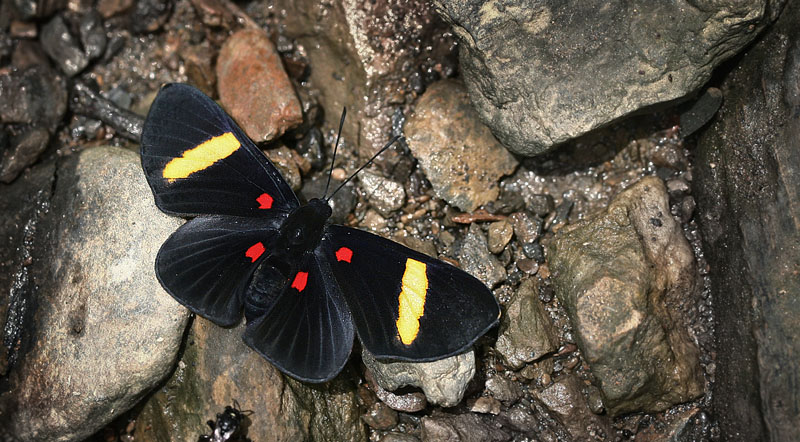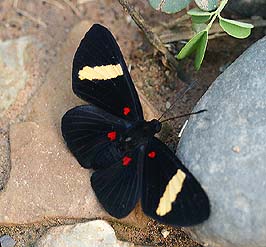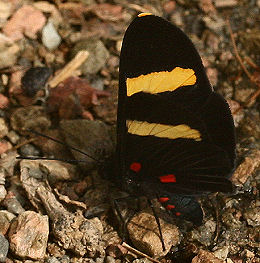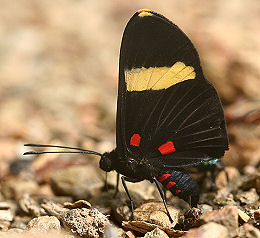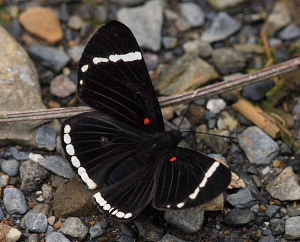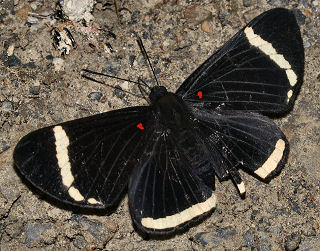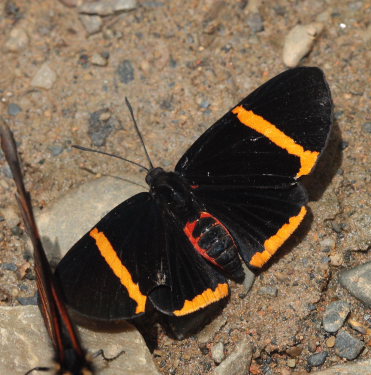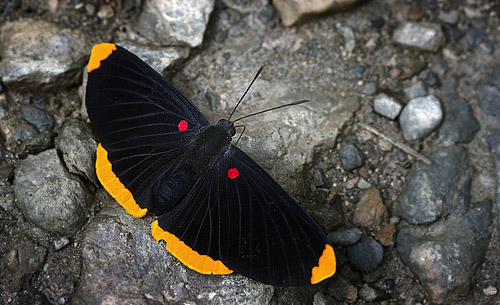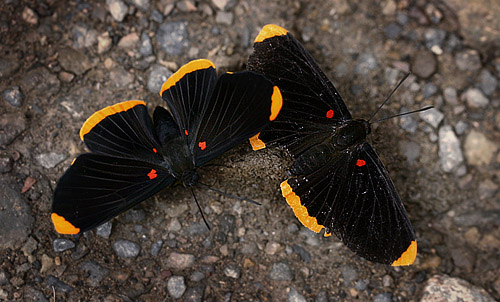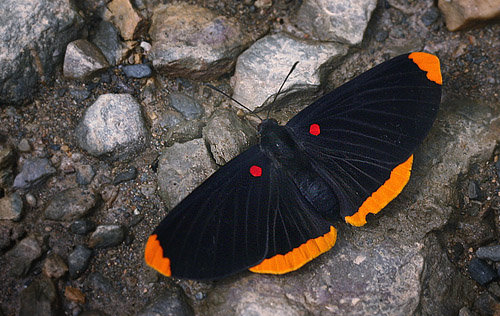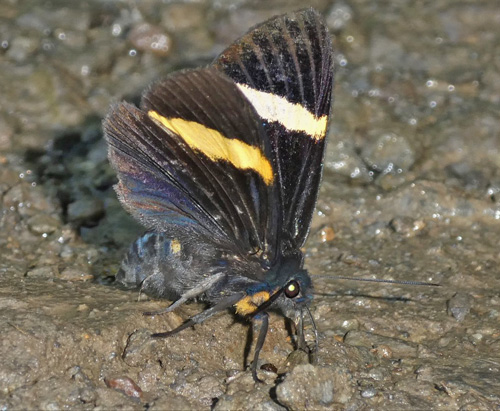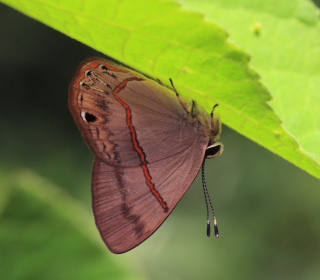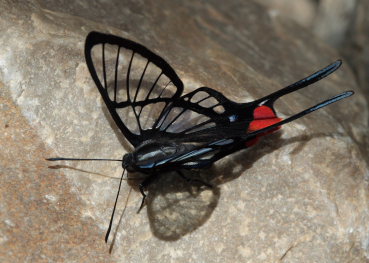Riodinidae
Mariposas de Bolivia
sitio 55
first update d. 22 december 2015
last update d. 18 january 2020
Redactor: Lars Andersen
bajo construccion
Metalmarks, Riodinidae
Subfamily Riodininae
Tribe Riodinini
_____________________
Black Metalmarks, Melanis
Electron Pixie, Melanis electron (Fabricius, 1793). Caranavi, Yungas, Bolivia d. 12 february 2007. Photographer; Lars Andersen
| The name Black
Metalmark, Melanis refers to the melanic pigment of
the black scales which cover the distinctively
shaped wings of all members of this genus. Many Melanis species are marked with orange
borders on the hindwings, and / or similarly
coloured diagonal bands on the forewings. In some
species the apex of the forewings is orange, and
in others there are large red spots near the base
of the wings. There are 27 known members in the genus. One particularly attractive species, Melanis pixe, has a range extending from Panama to Mexico and along the Rio Grande Valley in southern Texas. But the majority of species are found in the Andes mountains, or in the Amazonian lowlands. _____________________ Slægtnavnet Sortvinge, Melanis refererer til den melanitiske pigmentfarve på skæl, som dækker de markant formede vinger på alle medlemmer af denne slægt. De fleste Melanis arter er med orange sømbånd på bagvinge, og / eller lignende farvet diagonale bånd på forvinge. På nogle arter er apicalplet på forvingespids orange, og på andre er der store røde pletter nær forvinge rodfelt. Der findes 27 kendte arter i slægten, de fleste arter findes på Andesbjergenes østskråninger fra Venezuela, Colombia, Ecuador, Peru til Bolivia og i Amazonas lavland. En anden art som f.eks. Melanis pixe har en nordligere udbredelse, der strækker sig fra Panama til Mexico og langs Rio Grande dalen i det sydlige Texas. |
Electron Pixie, Melanis electron. Caranavi, Yungas, Bolivia d. 12 february 2007 & d. 30 january 2006. Photographer; Lars Andersen
_____________________
| Xenias Metalmark, Melanis xenia ambryllis (Hewitson, 1874). | ||
|
||
| Photographer: Lars Andersen |
_____________________
| Melanis cercopes (Hewitson, 1874). |
| Caranavi, Yungas, Bolivia d. 8 february 2009. |
| Photographer: Lars Andersen |
_____________________
Smith's Pixie, Melanis smithiae
Smith's Pixie, Melanis smithiae. Tocana, Yungas, Bolivia d. 2 february 2007. Photographer; Lars Andersen
| Smith's
Pixie, Melanis
smithiae (Westwood,
1851) Family - Riodinidae subfamily - Riodininae tribe - Riodinini Smith's Pixie, Melanis smithiae exhibits local and geographical variation in the extent of the orange markings. The red spots vary in size and are absent on the hindwings of many examples. Wing Span: 1 1/2 - 1 7/8 inches (38 - 44 mm.). This species is found from Brazil, Peru, Bolivia, Paraguay and further to Misiones in northern Argentina. Habitats: This species inhabits transitional rainforest / cloud forest in the eastern Andes, at altitudes between about 200-1000m. This species flies throughout the year but is commonest in the early part of the dry season. Lifecycle: no information available on its way of lifecycle is likely to be similar to that of other Melanis species : The larvae are hairy, and feed gregariously on the leaves of trees in the family Leguminosae. The pupae are said to be formed in clusters on tree trunks. _____________________ Smith's
Sortvinge, Melanis
smithiae (Westwood,
1851) Smith's Sortvinge, Melanis smithiae er en art som findes i flere lokale og geografiske underarter, hvis udseende variere i omfanget af de orange markeringer. Samt dens røde pletter varierer i størrelse og kan være fraværende på for og bagvinge. Vingefang: 38 - 44 mm. Udbredelse: findes fra Brasilien, Peru, Bolivia, Paraguay og videre til Misiones i det nordlige Argentina. Levesteder: Den findes i overgangs-periode regnskov / tågeskov i det østlige Andesbjergene, i højder mellem ca. 200-1000m. Flyvetid: hele året, men er mest almindelige i begyndelse af tørketiden. Livscyklus: Der findes ingen specifikke oplysninger om M. smithiae, men livscyklussen vil sandsynligvis være den samme som de andre Melanis arter. Larve er behårede, og findes i grupper på familien Ærteblomst, Leguminosae blade som er små buske til mindre træer. Dens puppe kan findes i små grupper på træstammer. |
Castnius pelasgus (Cramer, 1779)
Giant
Butterfly Moths, Castniidae family
sharing mimicry with Black Metalmark, Melanitis species. Riodinidae family.
Provincia
Caranavi, Yungas, Bolivia d. 17 january 2018. Photographer; Kirsten
Matthiesen
_____________________
Link til indlæg om Melanis på "kryb & kravl" på facebook d. 21 dec. 2015.
_____________________
dont use this pictures without permission from:
photographer © Lars Andersen
_____________________
Euselasiinae & Riodininae
sitio 55
_____________________
Swordtails - Riodinini
sitio 57
_____________________
METALMARKS part3 from Peter Møllmann on Vimeo.
Mariposas de Bolivia Enero 2009 por Peter Møllmann y Lars Andersen |
link to Neotropical Butterflies of Will Carter and Kim Garwood, Metalmarks
Esmeralda hotel, Coroico, Yungas
